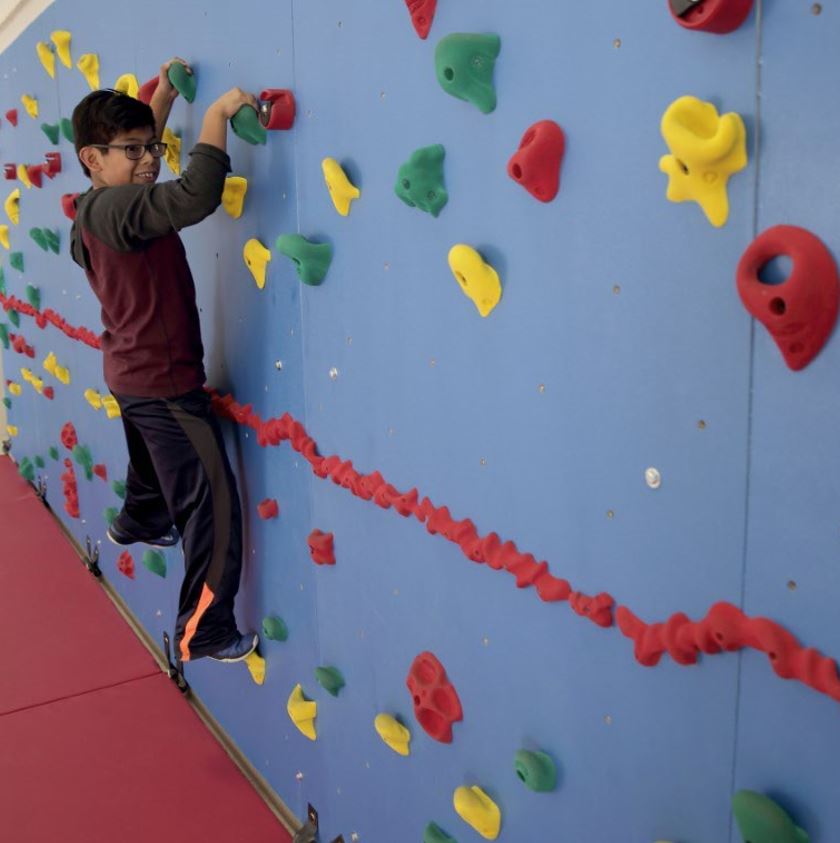
How to Differentiate Climbing Wall Activities
To help all children reap the many benefits of rock climbing, and remain engaged and excited over time, climbing activities should be differentiated to meet individual needs. This not only helps ease any apprehension, but also helps novice and experienced climbers alike develop new skills and abilities. With a little advance thought and some communication with your climbers, climbing wall activities can be differentiated.
First, it’s important to know that most of our climbing walls have built-in differentiation with regards to the hand holds. Most of our Traverse Walls® include color-coded hand holds in green, yellow and red. The green hand holds are our beginner-level holds and are typically the largest and easiest to grip. The yellow holds are intermediate level and are typically a little smaller and more challenging. The red grips are typically the most advanced and technical. Our 10’-high climbing walls and Top Rope Walls also include blue holds which bring another challenging color to the wall.
These color-coded hand holds differentiate the climbing experience by allowing climbers to choose their challenge. New climbers will probably use holds of every color to make their way across the climbing wall. We call this the “rainbow route.” As they advance in skill, they will graduate to route climbing, meaning climbing using holds of only one color. Using only the green holds would be the beginner route, followed by the yellow route and then the red route which would be the most challenging. As climbers progress in their route-climbing abilities, be sure they know that they can gradually move to another route by doubling up colors --using green and yellow holds before trying just the yellow holds. And they can always “borrow” a hold or two of any different color, if needed. This past blog post further explains our color-code system.
Please keep this information in mind and you review the following suggestions for differentiating climbing wall activities:
Simplifying Climbing Activities
- Have climbers use any color hand holds to complete the climb/activity.
- Encourage climbers to step down to take a rest or reposition themselves, if needed. We call this “borrowing the floor” and this wording helps climbers see it as a strategy rather than a failure. It's ok to take the climb slowly and in stages.
Adding Challenge to Climbing Activities
- Limit climbers to only using one color hold, or just the red and yellow holds.
- Limit climbers to a certain number of holds. For example, they can only use 15 total holds to get across or to the top of the climbing wall. This will require problem solving and using the same holds for both hands and/or feet.
Teaching Climbing Technique
- Teach basic climbing technique. Not everyone is a natural climber and direct instruction can help new or apprehensive climbers be successful.
- Experienced climbers can progress further if they are taught advanced climbing technique and advanced climbing moves. Encourage them to try these during activities.
Adding Encouragement
- Apprehensive climbers can be more motivated to try a climb when they are supported and encouraged by a fellow climber. Consider partner climbing where the climber has a walking partner nearby offering verbal assistance and motivation.
Adding Incentive
- Add a bell or stuffed animal to either end of a Traverse Wall® or the top of a Top Rope Wall. Reaching those objects is highly motivational and can also serve as a distraction for apprehensive climbers. Objects can even be placed partway along a route to help reach a goal incrementally.
Offering a Choice
- Not every climber has to be doing the activity in the same way—offer a choice. Here’s an example using the activity On Thin Ice:
- Choice One: You have magic powers and will not fall through thin ice. Climb and ignore the patches of thin ice and make your way across the climbing wall with the goal of resting/stepping down fewer times on subsequent climbs with the final goal of staying on the wall the entire climb.
- Choice Two: Climb and avoid the patches of thin ice, as described in the lesson plan.
- Choice Three: Climb and avoid the patches of thin ice but use only one color (or two colors) of hand hold. Try a different color (or color combination) on subsequent climbs.

Leave a comment